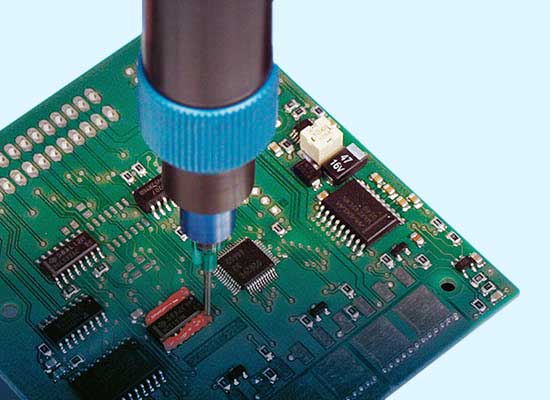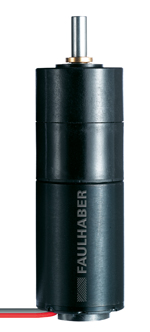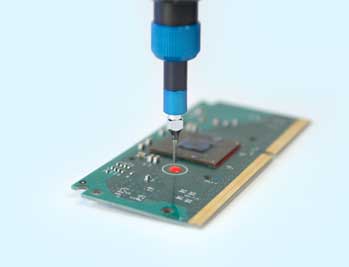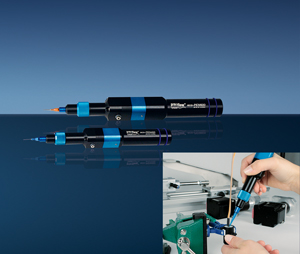 |
| October 20, 2015 | Volume 11 Issue 39 |
Designfax weekly eMagazine
Archives
Partners
Manufacturing Center
Product Spotlight
Modern Applications News
Metalworking Ideas For
Today's Job Shops
Tooling and Production
Strategies for large
metalworking plants
Volumetric dispenser: DC motor applications
Miniature drive powers conveyor rotor in precision dispenser.

Small is big. As a consequence, the spread of miniaturization in automation is leading to ever-increasing demands for optimum dosage of the tiniest quantities. Whether in electronics or micro-mechanical engineering: solder pastes, adhesives, lubricants, potting, and sealing compounds have to be applied precisely where they are needed, in exactly the right dosage, and with no spillage or dripping.

Precision volume dosage units are the method of choice when high flexibility allied to exact application is essential. In line with their usage, units of this type also have to be extremely compact. Thus, miniature drives are the most suitable power source for them. They deliver high performance in a compact design, and are highly dynamic as well as precisely controllable -- both attributes that are essential to a dosage unit.
Automatically dosing small quantities in a targeted way is no trivial matter. In fact, it demands detailed know-how and innovative strength. The specialist in precision volume dosage, the ViscoTec Pumpen-und Dosiertechnik GmbH brand, Preeflow®, based in Töging am Inn, Upper Bavaria, offers both of those qualities. So as not to be continually reinventing the (drive) wheel, the dosage specialists turned to the drive experts from FAULHABER. Together, they quickly devised a robust, precise motor solution for the dosage units.
Volumetric dosage
There are a number of possible methods of dosing ultra-small quantities. Dosage by volume has proved the most simple and flexible method in practice. The substance being transported only has to be brought to the dosage tip by constant flow pumps. The desired quantities are then delivered based on the known delivery quantity and time. Of course, here as in many tricky tasks, the devil is in the details.

Factors such as inconsistent viscosity, abrasive or more smearing substances, elasticity, tendency to drip, etc. must be taken into account when designing the dispenser unit. In the eco-PEN, those and other criteria are met on the basis of practical experience. The heart of the dispenser unit is a rotating, absolutely pressure-tight positive displacement system, comprising a self-sealing inner rotor and the outer stator. A controlled rotary motion of the rotor transports the medium by positive displacement. A reverser also permits the system to transport backward. This enables neat, controlled material separation with no dripping.
The medium itself is transported in a non-harmful way, without altering its structure. The system is designed to be self-sealing with water up to 2 bar delivery pressure. As the viscosity increases, so does the self-sealing effect. This makes it possible to achieve dosage pressures of 16 to 20 bar without problem.
This high delivery pressure, in turn, permits the use of a smaller needle and nozzle cross-sections for finer application areas. It is also possible to apply a basic admission pressure for high-viscosity media. This means that no pressure tank is needed for self-leveling fluids. In this way, 0.15 to 16.9 ml of medium per minute can be continuously transported with just three models. If point dosage is required, a minimum quantity of 0.001 ml, 0.004 ml, or 0.015 ml can be precision-placed, depending on the model.
For improved maintenance and cleaning when changing media, the volume dosage units are modular in design, comprising a drive unit and the actual dispenser unit, with a separate controller for the drive.
High-torque drive
The high potential delivery pressure in the dispenser module means a high torque drive is also essential. Given the restricted size of the unit, the only feasible option is a miniature motor with a gearhead.

Working with FAULHABER, the designers quickly found the right mini power pack for their needs. The best value for money was offered by a [coreless] brush dc motor with an encoder and planetary gearhead. The brush commutation provides for easy pulse width regulation and reversing.
Fitting the encoder and planetary gearhead within the motor diameter allowed the design to be kept slim. The gears and motor bearings are lifetime-lubricated and maintenance-free. The integrated encoder enables precision quantity dosage and drip-free separation of the medium based on exact feedback of the drive rotor position.
The gear reduction improves this resolution on the conveyor rotor of the dispenser module still further. The compact drive block, comprising the motor with the encoder and gearing, is just 22 mm in diameter, depending on dispenser model, while the motor is 32 mm long and the gear length is 27 to 48 mm (9 to 23014:1). The big brother is 26 mm in diameter and 42 mm long, with gear length from 28 to 60 mm (3.7 to 1526 :1).
The motors deliver 10 mNm of continuous torque at 6 to 24 VDC, with the big ones delivering 28 mNm at 12 to 48 VDC. This torque is increased as necessary by the specific gear to the level necessary for the dispenser unit at 20 bar delivery pressure. The plug-in encoder delivers 64 to 512 pulses per revolution depending on type, so in conjunction with the gear unit this produces a fine resolution of the conveyor rotor position. A custom cable connection feeds the operating voltage and encoder signal to the control unit.
Miniature dc drives are a space-saving alternative for many of today's drive applications. Power and size adapted gears and encoders are also available, enabling the drive to be integrated easily into many systems. The drive often replaces expensive, maintenance-intensive mechanical transmissions on site, or indeed makes a design concept feasible in the first place, thanks to its compact size.
To learn more about medical and lab automation applications and the micro motors that power them, please contact a MICROMO application engineer, or explore the MICROMO Motion System Selector to view FAULHABER products and motor configuration options.
Source: MICROMO
Published October 2015
Rate this article
View our terms of use and privacy policy
